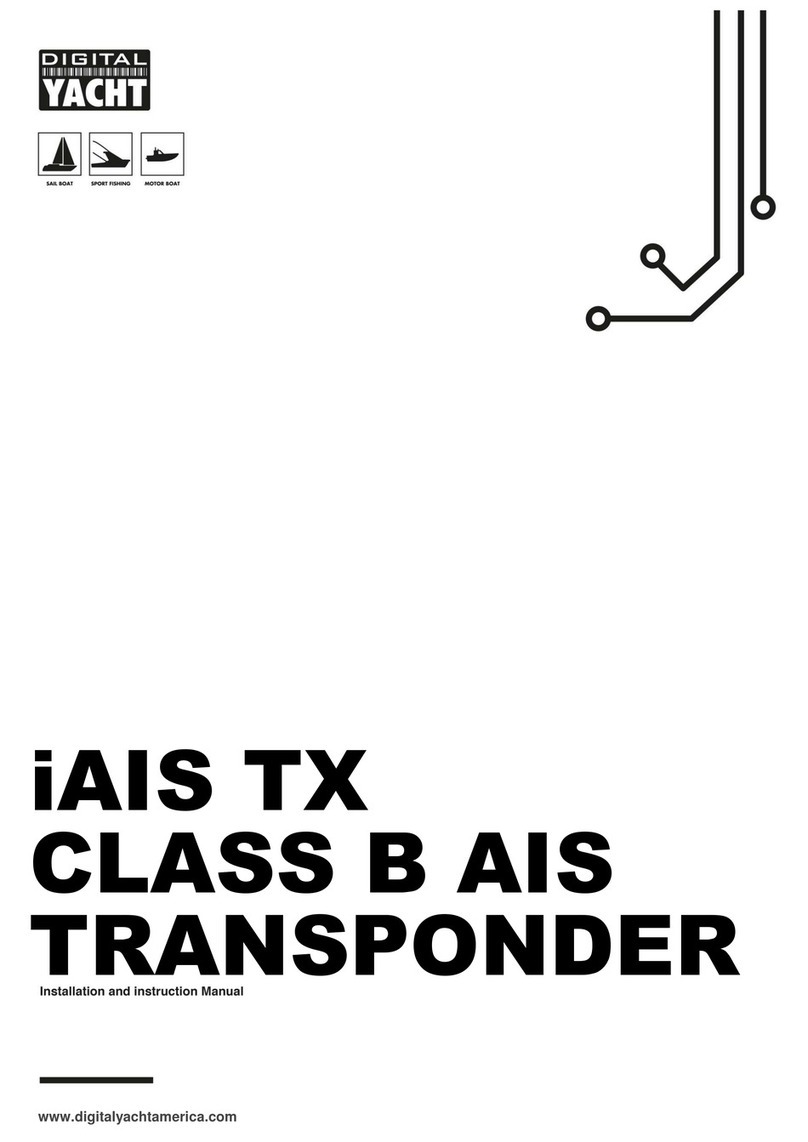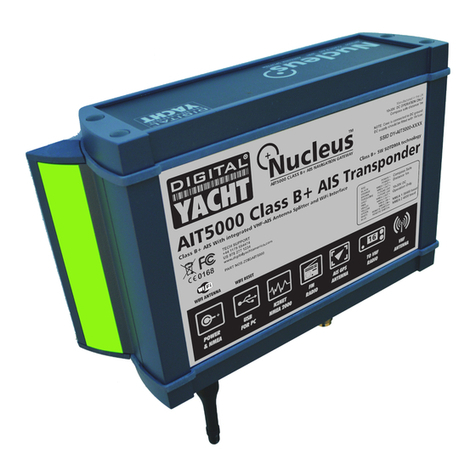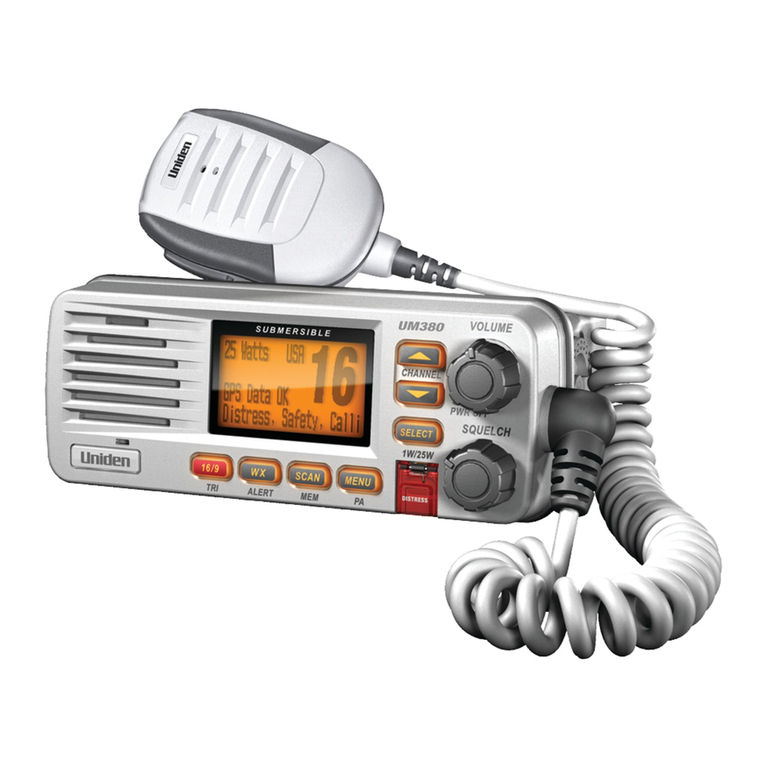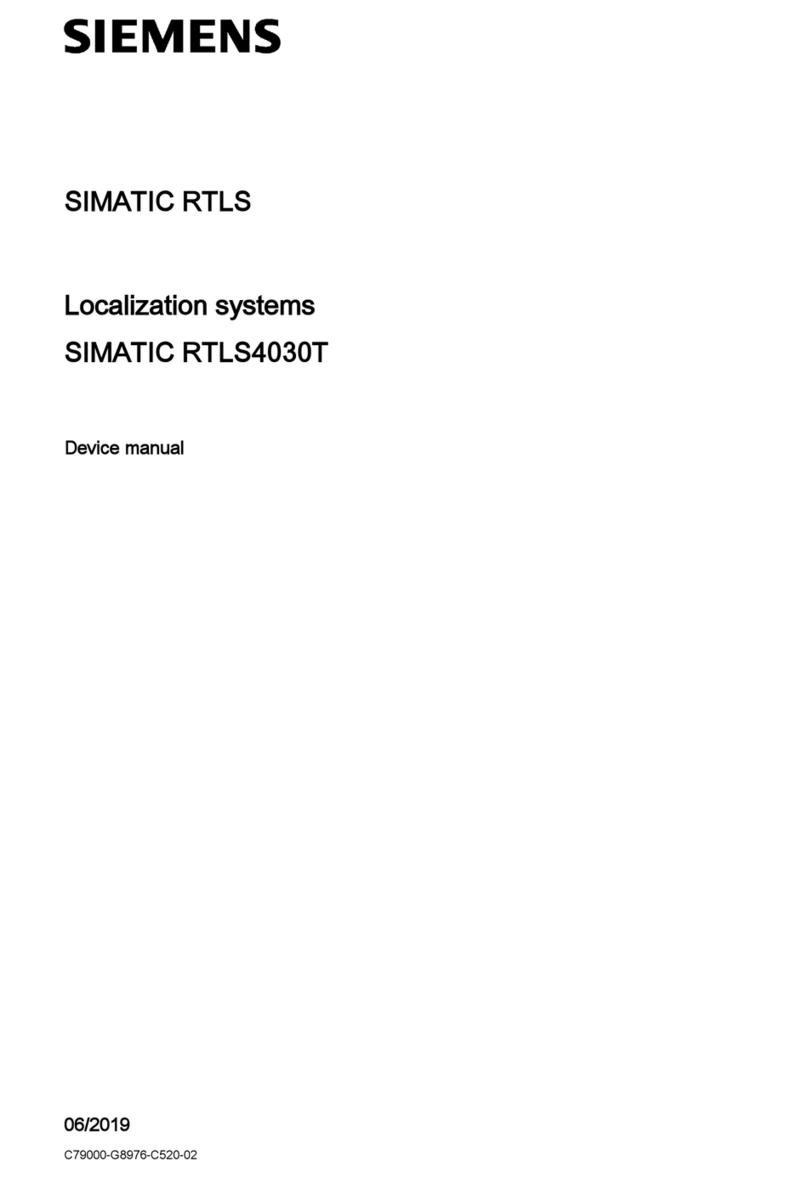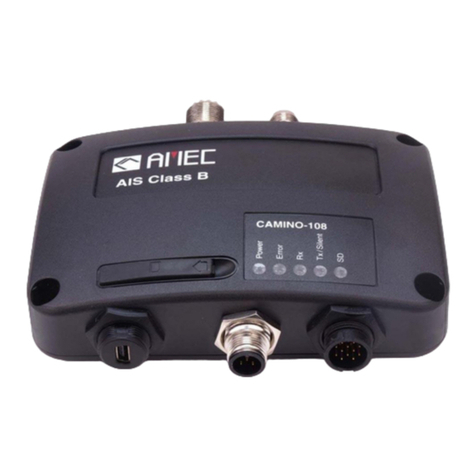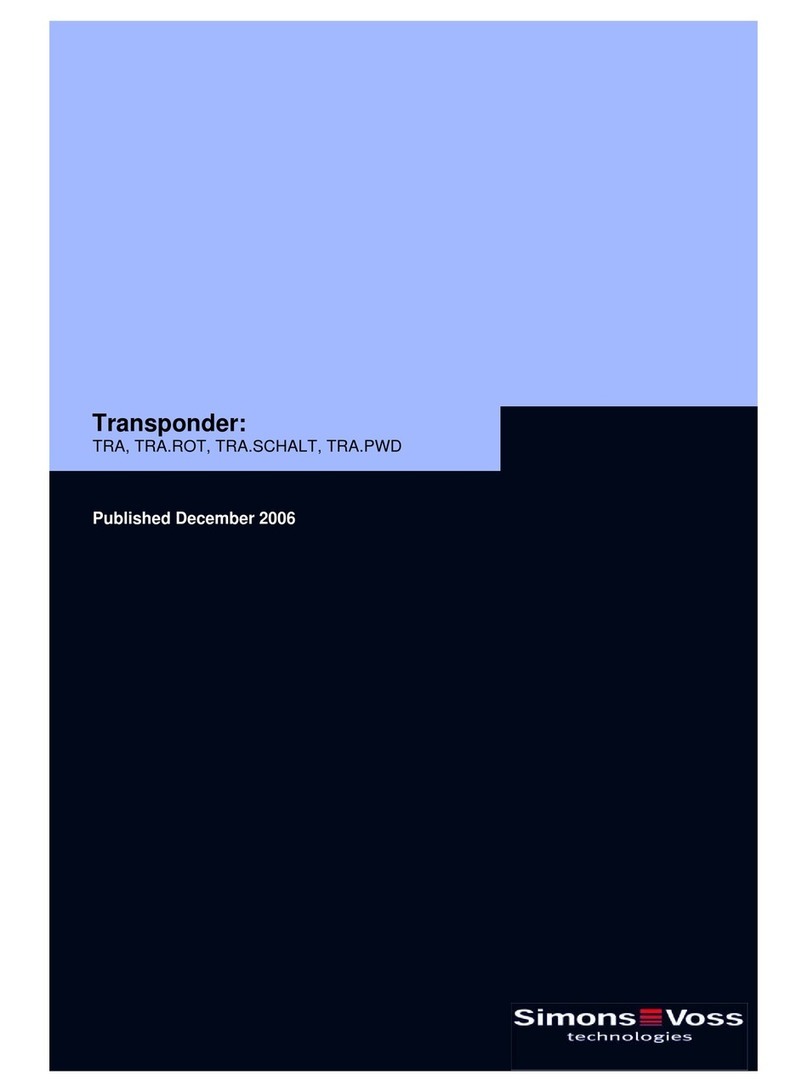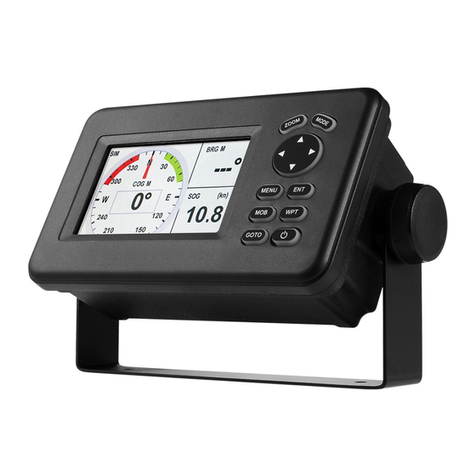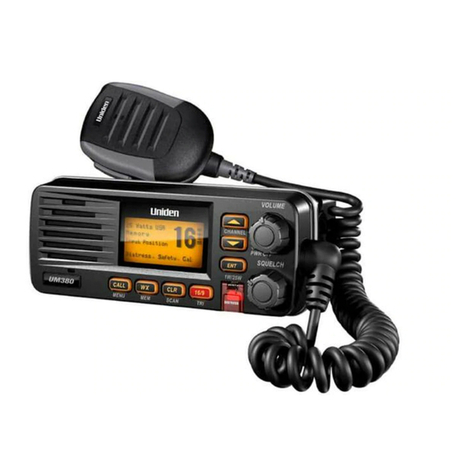DIGITAL YACHT AIT2000 User manual

For product support please see www.digitalyacht.co.uk Page 1
AIT2000 Installation & Operation Manual
VERSION 1.01
AIT2000 Installation
& Operation Manual

For product support please see www.digitalyacht.co.uk Page 2
AIT2000 Installation & Operation Manual
VERSION 1.01
Table of Contents
1 NOTICES ................................................................................................................................................................4
1.1 Safety Warnings............................................................................................................................................4
1.2 Position source .............................................................................................................................................4
1.3 Compass safe distance..................................................................................................................................4
1.4 RF emissions notice ......................................................................................................................................4
1.5 Warranty.......................................................................................................................................................5
1.6 Disposal of this product and packaging........................................................................................................5
1.8 Declaration of conformity ............................................................................................................................5
1.9 FCC notice .....................................................................................................................................................5
1.10 Industry Canada notice.................................................................................................................................6
2 ABOUT YOUR AIS CLASS B TRANSPONDER...........................................................................................................7
2.1 About AIS ......................................................................................................................................................7
2.2 Static and dynamic vessel data.....................................................................................................................7
2.3 Important information for US customers.....................................................................................................8
3 WHAT'S IN THE BOX ?...........................................................................................................................................9
3.1 Digital Yacht Software and Driver CD ...........................................................................................................9
3.2 GPS Antenna...............................................................................................................................................10
3.3 Power/Data and USB Cables.......................................................................................................................10
3.4 Electrical Connections ................................................................................................................................10
4 INSTALLATION.....................................................................................................................................................12
4.1 Preparing for Installation............................................................................................................................12
4.2 Optional “Silent” switch .............................................................................................................................13
4.3 VHF antenna cable......................................................................................................................................13
4.4 Power and data cable .................................................................................................................................14
4.5 Chart plotter ...............................................................................................................................................14
4.6 Connection to a PC or Mac .........................................................................................................................14
5 INSTALLATION PROCEDURES..............................................................................................................................15
5.1 Installing the AIS transponder ....................................................................................................................15
5.2 Installing the external GPS antenna ...........................................................................................................16
5.3 Connecting to the VHF antenna .................................................................................................................16
5.4 Connecting the Power/Data cable..............................................................................................................16
5.5 Connecting a “Silent” switch (optional)......................................................................................................17
5.6 Connecting to NMEA0183 compatible equipment ....................................................................................17
5.7 Connection to an NMEA2000 network (optional)......................................................................................19

For product support please see www.digitalyacht.co.uk Page 3
AIT2000 Installation & Operation Manual
VERSION 1.01
5.8 USB Connection (optional) .........................................................................................................................19
5.9 Connecting to a power supply....................................................................................................................20
6 CONFIGURING YOUR AIS TRANSPONDER...........................................................................................................21
6.1 Plugging the AIT2000 in to a Windows PC..................................................................................................21
6.2 Plugging the AIT2000 in to a Mac ...............................................................................................................22
7 OPERATION.........................................................................................................................................................26
7.1 Switch functions .........................................................................................................................................26
7.2 Indicator functions......................................................................................................................................26
8 TROUBLESHOOTING ...........................................................................................................................................28
9 SPECIFICATIONS..................................................................................................................................................29

For product support please see www.digitalyacht.co.uk Page 4
AIT2000 Installation & Operation Manual
VERSION 1.01
1 NOTICES
When reading this manual please pay attention to warnings marked with the warning triangle shown on
the left. These are important messages for safety, installation and usage of the product.
1.1 Safety Warnings
This equipment must be installed in accordance with the instructions provided in this manual. DO NOT in-
stall the equipment in a flammable atmosphere such as in an engine room or near to fuel tanks.
The Digital Yacht AIT2000 is an aid to navigation and must not be relied upon to provide accurate naviga-
tion information. AIS is not a replacement for vigilant human lookouts and other navigation aids such as
Radar. The performance of the AIT2000 may be seriously impaired if not installed as instructed in the user
manual, or due to other factors such as weather and or nearby transmitting devices. Compatibility with
other systems is reliant on third party systems recognising the standard outputs from the AIT2000. Digital
Yacht reserves the right to update and change these specifications at any time and without notice.
1.2 Position source
All marine Automatic Identification System (AIS) transponders utilise a satellite based location system such as the
Global Positioning Satellite (GPS) network. The accuracy of a GPS position fix is variable and is affected by factors
such as the antenna positioning, how many satellites are used to determine a position and how long satellite in-
formation has been received for.
1.3 Compass safe distance
The compass safe distance of this unit is 0.5m or greater for 0.3° deviation. We suggest you always mount the
unit 1m away from any compass and check for any localised interference
1.4 RF emissions notice
Caution: The AIS transponder generates and radiates radio frequency electromagnetic energy. This equipment
must be installed and operated according to the instructions contained in this manual. Failure to do so can result
in personal injury and / or AIS transponder malfunction. Caution: Never operate the AIS transponder unless it is
connected to a VHF antenna.
To maximise performance and minimise human exposure to radio frequency electromagnetic energy you must
make sure that the antenna is mounted at least 1.5 metres away from the AIS transponder and is connected to
the AIS transponder before power is applied. The system has a Maximum Permissible Exposure (MPE) radius of
1.5m. This has been determined assuming the maximum power of the AIS transponder and using antennas with a
maximum gain of 3dBi.The antenna should be mounted 3.5m above the deck in order to meet RF exposure re-
quirements. Higher gain antennas will require a greater MPE radius. Do not operate the unit when anyone is
within the MPE radius of the antenna (unless they are shielded from the antenna field by a grounded metallic
barrier). The antenna should not be co-located or operated in conjunction with any other transmitting antenna.
The required antenna impedance is 50 Ohms.

For product support please see www.digitalyacht.co.uk Page 5
AIT2000 Installation & Operation Manual
VERSION 1.01
1.5 Warranty
The AIT2000 is supplied with a standard 2 year return to base warranty as defined in the accompanying warranty
information. Any attempt to tamper with or damage this product will invalidate the warranty. Physical damage
and damage caused by salt water ingress are not covered under this warranty.
1.6 Disposal of this product and packaging
Please dispose of the AIS transponder in accordance with the European WEEE Directive or with the applicable lo-
cal regulations for disposal of electrical equipment. Every effort has been made to ensure the packaging for this
product is recyclable. Please dispose of the packaging in an environmentally friendly manner.
1.7 Accuracy of this manual
The AIS transponder may be upgraded from time to time and future versions of the AIS transponder may there-
fore not correspond exactly with this manual. Information contained in this manual is liable to change without
notice. The manufacturer of this product disclaims any liability for consequences arising from omissions or inac-
curacies in this manual and any other documentation provided with this product.
1.8 Declaration of conformity
Digital Yacht declare that this product is in compliance with the essential requirements and other provisions of
the R&TTE directive 1995/5/EC.
The product carries the CE mark, notified body number and alert symbol as required by the R&TTE directive.
The AIT2000 is intended for sale in the following member states: United Kingdom, France, Spain, Sweden, Austria,
Netherlands, Portugal, Denmark, Norway, Belgium, Italy, Finland, Ireland, Luxembourg, Germany and Czech Rep.
1.9 FCC notice
This equipment has been tested and found to comply with the limits for a class B digital device, pursuant to part
15 of the FCC Rules. These limits are designed to provide reasonable protection against harmful interference in a
residential installation.
This equipment generates, uses and can radiate radio frequency energy and, if not installed and used in accord-
ance with the instructions, may cause harmful interference to radio communications.
This device complies with part 15 of the FCC Rules. Operation is subject to the following two conditions: (1) This
device may not cause harmful interference, and (2) this device must accept any interference received, including
interference that may cause undesired operation.
Changes or modifications not expressly approved by the party responsible for compliance could void the user's
authority to operate the equipment.
WARNING: It is a violation of the rules of the Federal Communications Commission to input an MMSI that
has not been properly assigned to the end user, or to otherwise input any inaccurate data in this device.

For product support please see www.digitalyacht.co.uk Page 6
AIT2000 Installation & Operation Manual
VERSION 1.01
1.10 Industry Canada notice
This device complies with Industry Canada licence-exempt RSS standard(s). Operation is subject to the following
two conditions:
1. This device may not cause interference, and
2. This device must accept any interference, including interference that may cause undesired operation of
the device.
This Class B digital apparatus complies with Canadian ICES-003.
Le présent appareil est conforme aux CNR d'Industrie Canada applicables aux appareils radio exempts de licence.
L'exploitation est autorisée aux deux conditions suivantes :
1. L'appareil ne doit pas produire de brouillage, et
2. L'utilisateur de l'appareil doit accepter tout brouillage radioélectrique subi, même si le brouillage est sus-
ceptible d'en compromettre le Fonctionnement.
Cet appareil numérique de la classe B est conforme à la norme NMB-003 du Canada.

For product support please see www.digitalyacht.co.uk Page 7
AIT2000 Installation & Operation Manual
VERSION 1.01
2 ABOUT YOUR AIS CLASS B TRANSPONDER
2.1 About AIS
The marine Automatic Identification System (AIS) is a location and vessel information reporting system. It allows
vessels equipped with AIS to automatically and dynamically share and regularly update their position, speed,
course and other information such as vessel identity with similarly equipped vessels. Position is derived from the
Global Positioning System (GPS) and communication between vessels is by Very High Frequency (VHF) digital
transmissions.
There are a number of types of AIS device as follows:
Class A transponders
These are similar to class B transponders, but are designed to be fitted to large vessels such as cargo ships and
large passenger vessels. Class A transponders transmit at a higher VHF signal power than class B transponders and
therefore can be received by more distant vessels. They also transmit Class A transponders are mandatory on all
vessels over 300 gross tonnes on international voyages and certain types of passenger vessels under SOLAS regu-
lations.
Class B transponders
Similar to class A transponders in many ways, but are normally lower cost due to the less stringent performance
requirements. Class B transponders transmit at a lower power and at a lower reporting rate than class A tran-
sponders.
AIS base stations
AIS base stations are used by Vessel Traffic Systems to monitor and control the transmissions of AIS transponders.
Aids to Navigation (AtoN) transponders
AtoNs are transponders mounted on buoys or other hazards to shipping which transmit details of their location to
the surrounding vessels.
AIS receivers
AIS receivers will generally receive transmissions from class A transponders, class B transponders, AtoNs and AIS
base stations but do not transmit any information about the vessel on which they are installed.
This product is an AIS Class B transponder.
2.2 Static and dynamic vessel data
There are two categories of information transmitted by an AIS transponder: static and dynamic data.
The vessel's dynamic data, which includes location, speed over ground (SOG) and course over ground (COG), is
calculated automatically using the internal GPS receiver.
Static data is information about the vessel which must be programmed into the AIS transponder. This includes:
Maritime Mobile Service Identity (MMSI)

For product support please see www.digitalyacht.co.uk Page 8
AIT2000 Installation & Operation Manual
VERSION 1.01
Vessel name
Vessel call sign (if available)
Vessel type
Vessel dimensions
In most countries the operation of an AIS transponder is included under the vessel's marine VHF licence provi-
sions. The vessel on to which the AIS unit is to be installed must therefore possess a current VHF radiotelephone
licence which lists the AIS system, vessel Call Sign and MMSI number.
An MMSI number is required in order for the AIS transceiver to operate. Please contact the relevant au-
thority in your country for more information.
2.3 Important information for US customers
There are specific laws in the USA regarding the configuration of AIS class B transponders.
If you are a US resident and intend to use your AIS class B transponder in US waters, you should make sure that
your retailer has configured your product prior to supplying it to you. If your AIS transponder has not been
pre-configured please contact your dealer for details of how to have it configured.

For product support please see www.digitalyacht.co.uk Page 9
AIT2000 Installation & Operation Manual
VERSION 1.01
3 WHAT'S IN THE BOX ?
These items are included with your AIS transponder purchase.
AIT2000 Transponder (with integrated connections for power, NMEA and USB)
GPS ANTENNA
QUICK START GUIDE
DIGITAL YACHT SOFTWARE AND DRIVER CD
The following sections give a brief overview of each item. Please ensure all items are present and if any of the
items are not present contact your dealer.
3.1 Digital Yacht Software and Driver CD
The CD supplied with the package contains the following:
proAIS2 software tool necessary to configure the AIS transponder. Two versions of the program are on
the CD, one for PCs running Windows and one for Macs running OSX (Intel only). Please refer to section

For product support please see www.digitalyacht.co.uk Page 10
AIT2000 Installation & Operation Manual
VERSION 1.01
6 CONFIGURING YOUR AIS TRANSPONDER for details of the configuration process and how to use
the proAIS2 tool. NOTE - products supplied in the USA will be pre-programmed by a dealer or competent
authority.
USB drivers required by Windows to connect to the AIS transponder via USB (installed with the proAIS 2
software). The USB drivers for Mac are already included in the OSX operating system and are automati-
cally installed when you plug the AIT2000 USB lead in to the Mac.
Alternative language versions of this manual.
A Quick start guide, that gives a handy reference for installation process.
Product manual - This document is the product manual and should be read thoroughly prior to any at-
tempt to install or use the AIS transponder.
SmarterTrack Lite AIS Viewing Software
Other useful programs and utilities
3.2 GPS Antenna
The AIS transponder requires an external GPS antenna (as supplied). The supplied GPS antenna is designed to be
fitted to a standard 1”x14 TPI threaded VHF pole mount, which are available in many different styles from all
good marine electronic dealers and chandleries.
It is possible to use any existing GPS antenna as long as it is a passive GPS type antenna with a 3v or 5v
pre-amplifier. It is not possible to connect another GPS unit to the AIT2000 via NMEA. The international Class B
Transponder specification states that a transponder must have its own GPS to ensure that it can work entirely on
its own without being reliant upon other external equipment.
The GPS antenna supplied with the AIT2000 comes complete with 10m of cable and is terminated in a TNC con-
nector. The cable can be lengthened but this should be done using a suitable TNC (Male) to TNC (Female) exten-
sion cable or carried out by an experienced and qualified Marine Electronics Dealer. Any joins in the cable should
be made to a professional standard suitable for the marine environment.
3.3 Power/Data and USB Cables
The integral 1 metre Power and Data cable allows power, NMEA 0183 data and an optional “Silent Switch” to be
connected to the AIT2000 transponder. This twelve core cable can be extended using suitable marine grade ca-
bles . To aid installation, a table of the wire connections and colours, is printed on the AIT2000 product label.
The integral 1 metre USB cable allows a power and data connection between the AIT2000 and a computer. The
AIT2000 will take enough power from the USB connection to operate as an AIS Receiver. This is useful for initial
programming/configuration of the AIT2000 with your MMSI number and other vessel data, which can be done at
home or in the office without the need of an additional 12v DC supply. It should be noted that the AIT2000 will
not operate as a Transponder without an external power supply connected to the Red and Black Wires of the
Power/Data cable.
3.4 Electrical Connections
The AIT2000 transponder has the following electrical connections:

For product support please see www.digitalyacht.co.uk Page 11
AIT2000 Installation & Operation Manual
VERSION 1.01
Power supply 12v or 24v
Two NMEA0183 data ports for connection to chart plotters and other NMEA0183 compatible equipment
USB for connection to a PC or Mac
External switch input for silent mode control (on power/data cable)
NMEA2000 port for connection to NMEA2000 compatible equipment
In addition there are two other connections for the VHF antenna and the external GPS antenna.
Figure 1 shows the electrical connections to the AIT2000 transponder.
Figure 1

For product support please see www.digitalyacht.co.uk Page 12
AIT2000 Installation & Operation Manual
VERSION 1.01
4 INSTALLATION
4.1 Preparing for Installation
Figure 2 below shows a typical installation of an AIT2000. Please take the time to familiarise yourself with the
system elements and their connections prior to attempting installation.
In addition to the items provided with your AIS transponder the following items will be required for installation:
VHF antenna or suitable splitter if you intend to use your existing VHF antenna
Four M4 screws or other fixings for the AIT2000 appropriate to the mounting location
A suitable 1”x14TPI thread mount for the GPS Antenna (not supplied)
Connection to a suitable VHF antenna will be required for the AIS transponder to operate. A standard marine
band VHF antenna can be used, however, many manufacturers are now offering AIS tuned (162MHz) antennas
that offer even better performance. Digital Yacht have a selection of suitable VHF antennas.
Alternatively, if you wish to use the vessel’s existing VHF antenna, our SPL2000 antenna splitter product is
available which allows the existing antenna to be used by the VHF voice radio and the AIT2000. On the
following page Figure 3, shows a typical splitter installation diagram showing how the AIT2000 and
SPL2000 should be connected to the vessel’s existing VHF antenna.
Figure 2

For product support please see www.digitalyacht.co.uk Page 13
AIT2000 Installation & Operation Manual
VERSION 1.01
4.2 Optional “Silent” switch
A switch can be connected to the transponder to enable and disable 'silent mode'. A standard “Single Pole Single
Throw” (SPST) toggle switch is required to use this feature. When the switch is “closed” the AIT2000 stops trans-
mitting and when the switch is “open” the AIT2000 starts transmitting again.
4.3 VHF antenna cable
Please check that the VHF antenna you intend to use has sufficient cable to reach between the VHF antenna and
the AIS transponder unit. If it is not sufficient you will need an extension cable. Please contact your dealer for de-
tails of suitable products. For reference the VHF antenna connector type on the AIS transponder unit is BNC fe-
male, and is intended to mate with a BNC male connector.
Figure 3

For product support please see www.digitalyacht.co.uk Page 14
AIT2000 Installation & Operation Manual
VERSION 1.01
4.4 Power and data cable
The AIS transponder unit is supplied with a 1m long power and data cable integrated into the unit. If you require
longer cables to reach your power supply, please ensure the cables are capable of carrying currents of up to 2A
peak and 200mA on average. Means of connecting the cables together will also be required. The use of Scotchlok
type connectors is recommended for this purpose.
4.5 Chart plotter
To display received AIS messages as other vessels on your chart plotter, you will need to connect your AIS tran-
sponder to your chart plotter. This is usually done via NMEA 0183 or via NMEA 2000, which are the marine indus-
try standards for digital communication.
Please refer to the user manual supplied with your chart plotter for details of how to connect and configure your
chart plotter for use with AIS devices. For NMEA 0183 data connections, your chart plotter should be configured
to accept NMEA data at 38400 baud (sometimes referred to as 'NMEA HS' in the plotter configuration menu). You
may also need to enable the display of AIS targets in the chart options.
Alternatively if you use an NMEA2000 network on your vessel it is possible to connect the AIS transponder to the
NMEA2000 network via the integral cable. Assuming that you are connecting to an existing NMEA2000 network,
you should be abel to simply “plug and play” the AIT2000 in to a spare “T-piece” connector on the network.
Please refer to your dealer and to the chart plotter manual for more information on NMEA2000 networking.
4.6 Connection to a PC or Mac
If you choose to use a PC or Mac with suitable charting software to display received AIS messages as other vessels,
this can be accomplished by connecting the USB cable integrated into the unit.

For product support please see www.digitalyacht.co.uk Page 15
AIT2000 Installation & Operation Manual
VERSION 1.01
5 INSTALLATION PROCEDURES
It is strongly recommended that you read all of the instructions in this manual prior to installation.
If after reading this manual you are unsure about any element of the installation process please contact your
dealer for advice.
The following sections explain the installation process step by step for each of the main elements of the system.
5.1 Installing the AIS transponder
Please note the following guidelines when selecting a location for your AIS transponder:
The AIS transponder must be fitted in a location where it is at least 0.5m from a compass or any magnetic
device.
There should be adequate space around the AIS transponder for routing of cables. See drawing below for
details of the AIS transponder dimensions.
The ambient temperature around the AIS transponder should be maintained between -25°C and +55°C.
The AIS transponder should not be located in a flammable or hazardous atmosphere such as in an engine
room or near to fuel tanks.
The AIS transponder is fully waterproof to ingress protection rating IPx5, however it is recommended that
the AIS transponder is not subjected to extended periods of exposure to spray or submersion.
It is recommended that the AIS transponder is installed in a 'below decks' environment.
It is acceptable to mount the AIS transponder either vertically or horizontally.
Remove the green décor strips to expose 4 mounting holes to screw the unit to a suitable bulkhead or
surface.
The AIS transponder should be mounted in a location where the indicators are readily visible as these
provide important information on the status of the AIS transponder.

For product support please see www.digitalyacht.co.uk Page 16
AIT2000 Installation & Operation Manual
VERSION 1.01
5.2 Installing the external GPS antenna
For mounting of the optional external GPS antenna you will require a 1” x 14 TPI thread pole, deck base or
rail mount
You should ensure the GPS antenna has a good clear view of the entire sky.
It is not recommended that the GPS antenna is mounted up a mast
where the motion of the vessel will cause the antenna to swing and
potentially reduce the accuracy of the GPS position.
Do not mount your antenna in the direct path of a radar transmitter.
Feed the ten metre long cable attached to the GPS antenna cable
through the pole and screw the antenna onto the pole mount as
shown in Figure 4.
Route the cable to your AIS transponder unit, adding any necessary
extension cables.
Connect the cable from the GPS antenna to the GPS connector on the
AIS transponder
5.3 Connecting to the VHF antenna
Route the cable from the VHF antenna or splitter to the AIS transponder and connect to the VHF connector on the
AIS transponder.
A standard marine band VHF antenna or AIS antenna should be used with the AIS transponder. The con-
nector type on the AIS transponder is a BNC. Your chosen VHF antenna requires a BNC male connector to
mate with this. If your VHF antenna does not use this type of connector please contact your dealer for
details of available adaptors.
If you are using an antenna splitter, connect the AIS connection on the splitter to the VHF (BNC) connect-
or on the AIT2000.
NOTE –if you intend to use a splitter, it is important that the splitter is designed for use with a Class B
Transponder. Some lower cost splitters are only designed for use with AIS receivers and will not work
properly with the AIT2000.
5.4 Connecting the Power/Data cable
The integral 1m Power/Data cable allows connection of DC power, NMEA data (two inputs and two out-
puts) and the remote Silent Switch. The cable is terminated inside the unit and the other end of the cable
has twelve colour coded bare wires ready for connection.
Table 1 on the following page lists the function of each colour coded wire for reference.
Figure 4

For product support please see www.digitalyacht.co.uk Page 17
AIT2000 Installation & Operation Manual
VERSION 1.01
Wire colour
Description
Function
RED
Power in +
Power supply connections
BLACK
Power in -
BLUE
Switch input-
External switch connection for silent mode
WHITE
Switch input+
ORANGE
NMEA0183
port 1 TX+
High speed NMEA0183 output (38,400 baud) intended for connection
to chart plotters
BROWN
NMEA0183
port 1 TX-
TURQUOISE
NMEA0183
port 1 RX+
High speed NMEA0183 input (38,400 baud)
Not normally used
GREY
NMEA0183
port 1 RX-
PINK
NMEA0183
port 2 TX+
Low speed NMEA0183 Output (4,800baud) intended for connection to
other NMEA0183 devices requiring a GPS feed. Note AIS data is not
available on this output.
VIOLET
NMEA0183
port 2 TX-
YELLOW
NMEA0183
port 2 RX+
Low speed NMEA0183 input (4,800baud) intended for connection to
other NMEA0183 compatible sensors for multiplexing of data to the
chart plotter
GREEN
NMEA0183
port 2 RX-
Table 1
5.5 Connecting a “Silent” switch (optional)
A toggle switch can be connected to the AIS transponder to provide remote control of silent mode.
Connect the toggle switch between the White(+) and Blue(-) wires as shown below. Connection of an ex-
ternal switch to toggle silent mode is optional and not essential for normal operation of the product.
Figure 5
5.6 Connecting to NMEA0183 compatible equipment
The AIT2000 has two independent NMEA0183 data ports which are pre-configured at the following data
rates; Port 1 = 38400 baud and Port 2 = 4800 baud.
Each port consists of a two wire Input and a two wire Output, which are colour coded as shown in Table 1.
Connect the wires to the appropriate connections on your NMEA0183 compatible equipment. Please re-
fer to your equipment manual for more information and pay particular attention to any menu settings
that must be configured to configure and display AIS or other NMEA data.
The high speed NMEA Output port 1 is intended primarily to connect to a chart plotter, while the low
speed NMEA Input and Output of port 2 are intended to connect to other NMEA0183 devices.

For product support please see www.digitalyacht.co.uk Page 18
AIT2000 Installation & Operation Manual
VERSION 1.01
A multiplexing feature is provided, which means any messages which are received on the low speed Input
2 port are automatically transmitted on the high speed Output 1 port. This is particularly useful when us-
ing a chart plotter having only a single NMEA0183 port.
Instrument data or additional sensors such as a gyro-compass can be connected to the AIS transponder
via the low speed port and all of this data, plus the AIS and GPS data will be transmitted on the high speed
Output 1 port to the chart plotter. Please ensure your equipment is configured to use the correct baud
rate for the port it is connected to.
On many vessels fitted with a modern VHF Radio that requires GPS data for the DSC functions, the low
speed NMEA Output 2 can be used to give GPS data to the VHF radio. On this port are the following
common NMEA 0183 GPS position sentences; GLL, GGA and RMC.
Figure 6 below is a diagram of a typical installation showing the NMEA 0183 data connections. The Head-
ing data (or any instrument data) received on Input 1 is multiplexed (combined) with the AIT2000’s own
AIS and GPS data and sent to the Chart Plotter on Output 1 (38400 baud). The GPS inside the AIT2000 is
used to provide the VHF DSC radio with GPS position data on Output 2 (4800 baud).
Figure 6

For product support please see www.digitalyacht.co.uk Page 19
AIT2000 Installation & Operation Manual
VERSION 1.01
5.7 Connection to an NMEA2000 network (optional)
The AIT2000 also has an N2Net connection which is Digital Yacht’s NMEA2000 compliant interface. To
connect to other NMEA2000 products, simply find or add a spare NMEA2000 “T” piece on the existing
NMEA2000 network and connect the receiver’s N2Net connector to the “T” piece.
The N2Net cable is just over 1m long and is terminated in an NMEA2000 Micro Male Connector.
The AIS200N2NET does not take any power from the NMEA2000 network.
The Load Equivalency Number (LEN) of the AIT2000 is 1.
The AIT2000 now outputs AIS data and GPS data on to the network (GPS added with V1.7 firmware), it
does not provide any other NMEA0183 to NMEA2000 conversion.
The list of AIS PGNs that the AIT2000 outputs is listed below in Table 2;
PGN No.
PGN Title
129038
Class A Position Report
129039
Class B Position Report
129040
Class B Extended Position Report
129793
AIS UTC and Date report
129794
AIS Class A Static and Voyage Related Data
129800
AIS UTC/Date Inquiry
129801
AIS Address Safety Message
129802
AIS Broadcast Safety Message
129810
AIS Class B static data part B
129809
AIS Class B static data part A
129041
AtoN position report
129025
Position –rapid update
129026
COG/SOG –rapid update
Table 2
5.8 USB Connection (optional)
The AIS transponder is supplied with a USB cable for connection to a PC or Mac. The USB connector can be con-
nected directly to the USB port on the PC or Mac via the supplied USB cable. To enable connection of the AIS
transponder to a PC the USB drivers, supplied on the product CD, must first be installed.
Driver installation is only necessary on a Windows PC as the drivers are pre-installed in the Mac operating
system and automatically load when the AIT2000 is plugged in.
To install the drivers on a Windows PC please follows the steps below:
Insert the product CD and in the proAIS2 for AIT2000 folder, either double click the Setup.Exe file if you
are running Windows XP or right click on the Setup.Exe file and select “Run as administrator”if you are
running Windows Vista, 7 or 8

For product support please see www.digitalyacht.co.uk Page 20
AIT2000 Installation & Operation Manual
VERSION 1.01
Once installed the AIS unit can be connected to the PC. The USB drivers will be installed automatically and
the AIS will appear as a new COM port device.
Select the AIS COM port and a baud rate of 38,400 in PC based navigation software to make use of the AIS
data.
5.9 Connecting to a power supply
The AIT2000 should be connected to the ship’s 12V or 24V DC power supply typically provided by the vessel's
battery.
It is recommended that crimped and soldered lugs are used to connect the AIS transponder to the power source.
It is recommended that the power supply is connected via a suitable circuit breaker and/or 3A fuse
Connect the red wire to a 12V or 24V power supply positive terminal.
Connect the black wire to the supply negative terminal.
The AIT2000 will only operate correctly as a Class B transponder when it is connected to an external supply that
has a voltage greater than 9.6v. If the supply voltage is less than 9.6v or the AIT2000 is only powered through the
USB cable, then the AIT2000’s GPS circuitry will be powered down and the unit will only operate in AIS Receiver
mode.
The AIT2000 can be powered from the USB port for configuring the unit (programming MMSI number,
etc.) which is useful for initially setting the unit up when first purchased. The following section explains
how to configure the AIT2000 for correct operation.
Other manuals for AIT2000
4
Table of contents
Other DIGITAL YACHT Marine Radio manuals
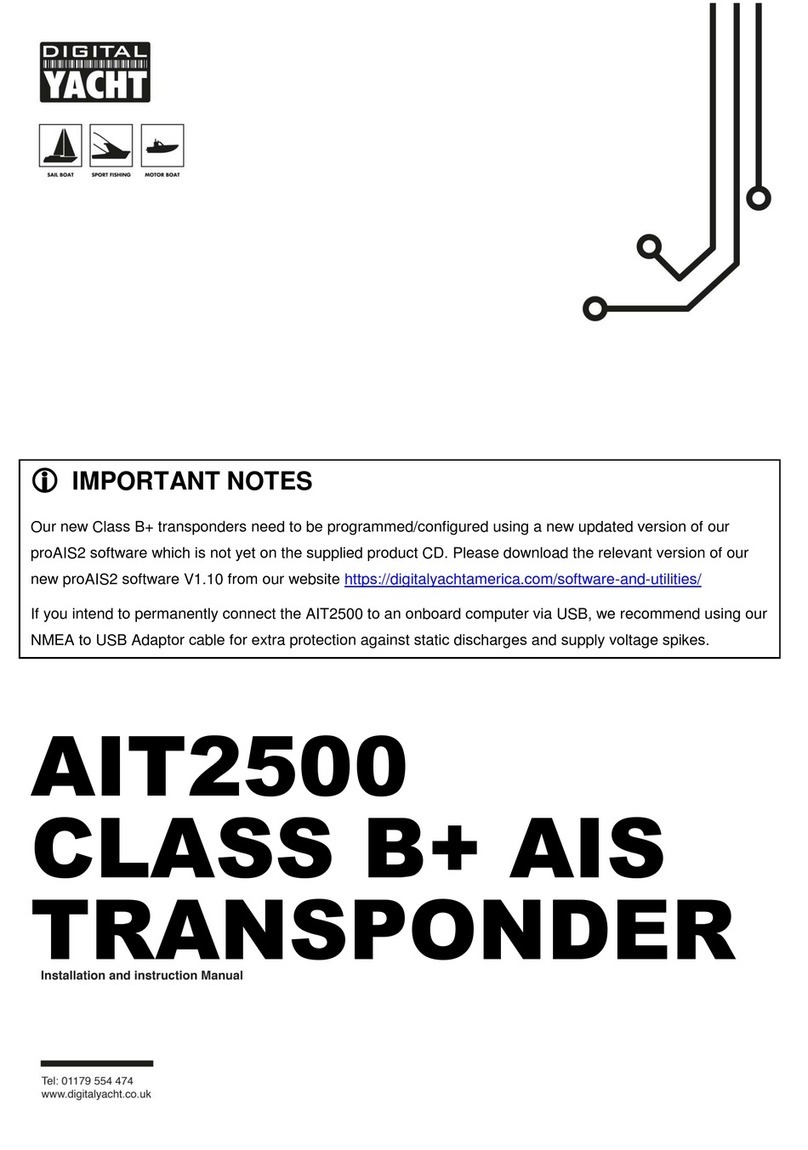
DIGITAL YACHT
DIGITAL YACHT AIT2500 Quick guide

DIGITAL YACHT
DIGITAL YACHT NOMAD Quick guide
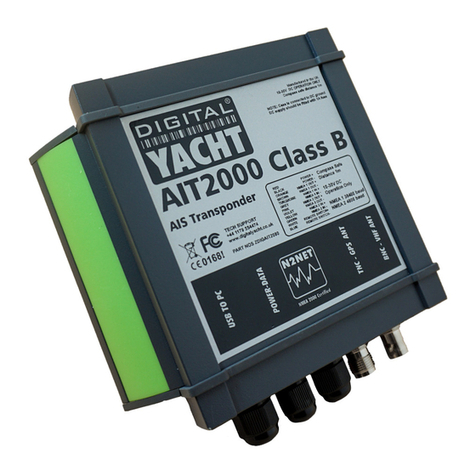
DIGITAL YACHT
DIGITAL YACHT AIT2000 Specification sheet
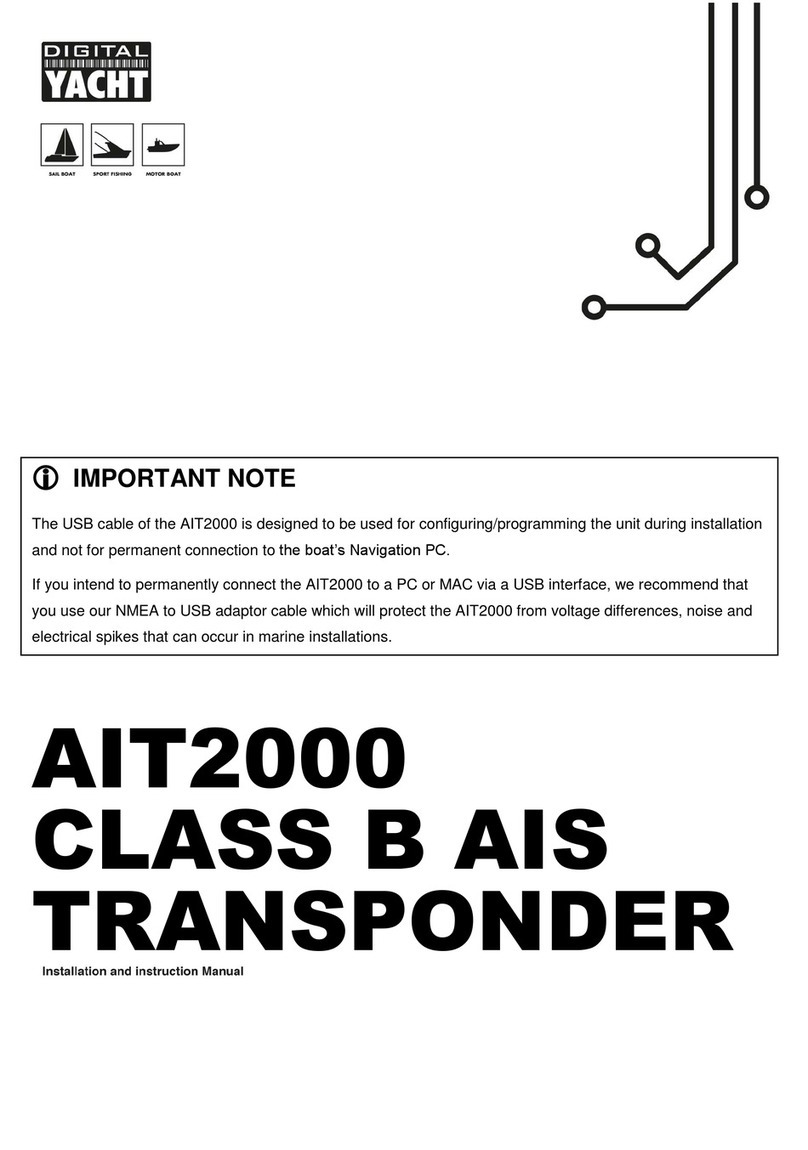
DIGITAL YACHT
DIGITAL YACHT AIT2000 Quick guide

DIGITAL YACHT
DIGITAL YACHT AIT2000 User manual

DIGITAL YACHT
DIGITAL YACHT AIT2000 Specification sheet
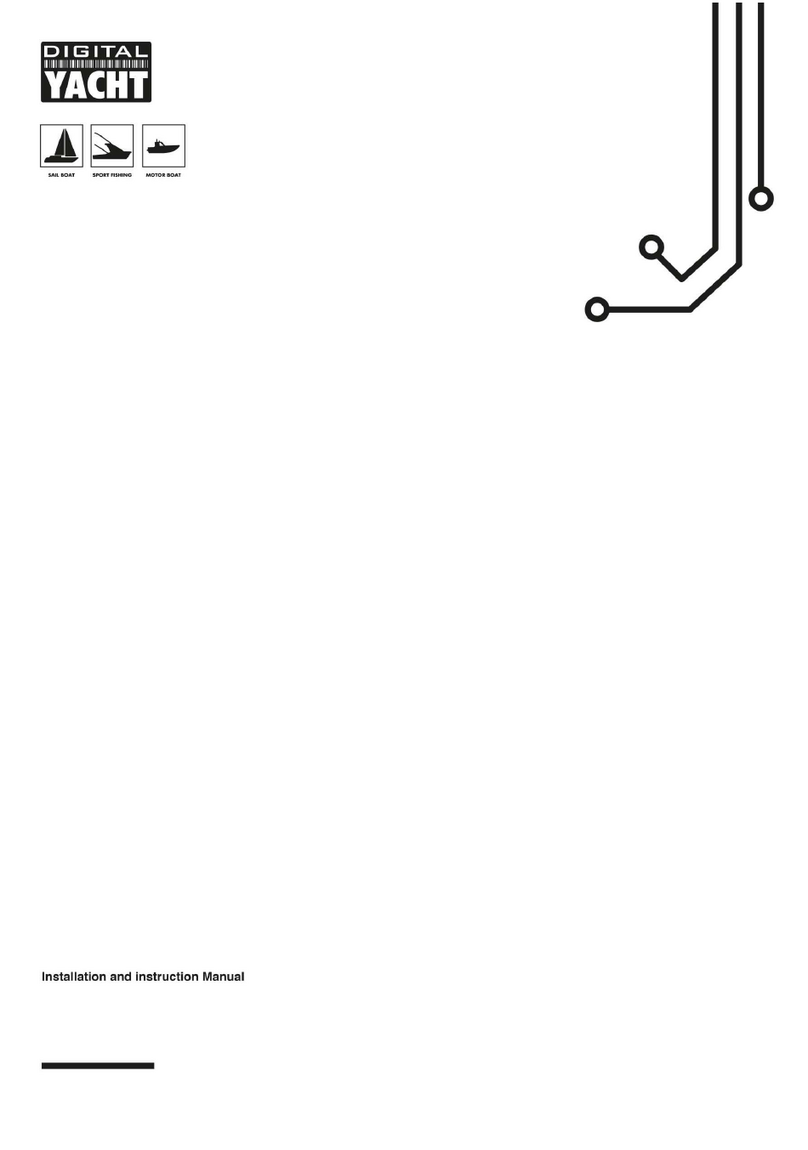
DIGITAL YACHT
DIGITAL YACHT NOMAD2 Quick guide

DIGITAL YACHT
DIGITAL YACHT AIT250 Datasheet

DIGITAL YACHT
DIGITAL YACHT AIT1500 Quick guide

DIGITAL YACHT
DIGITAL YACHT AIT1000 Datasheet
